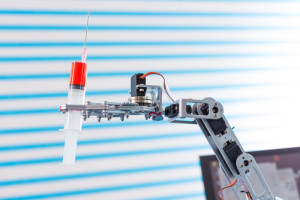Four Industries Benefiting from Robotic Process Automation

Improvements in productivity and profitability and the ease and speed of implementation are driving fast-growing interest in robotic process automation (RPA). In terms of technical capabilities, RPA differentiates itself from other forms of robotics by working on the surface level of the IT infrastructure without disrupting legacy systems and by being a ‘swivel chair’ of innovation, fit for business processes that require integration with multiple systems.
The list of business processes that are suited for automation is virtually endless. As a guideline, RPA addresses processes that involve high-volume, clerical, repetitive tasks that are rules-driven and screen-based.
For context, let us look at four key industries where the conditions for automating business processes are favorable.
Business Process Outsourcing
BPO clients demand no stone is left unturned as far as process improvement goes, with the mantras of innovation and cost reduction typically spelled out in contracts. Since RPA robots operate at a fraction of the cost of a human – around the clock and with near zero error rates – they show strong potential in their ability to capture the outsourcing market.
 BPO providers generally regard RPA as either a competitive threat or an opportunity to extend their business propositions. Some may try to counteract RPA vendors' disruptive force by developing their own in-house automation tools. However, since RPA vendors can offer BPOs a ready made, industry standard platform for them to build automations and solutions, a partnership would probably be the more justifiable scenario.
BPO providers generally regard RPA as either a competitive threat or an opportunity to extend their business propositions. Some may try to counteract RPA vendors' disruptive force by developing their own in-house automation tools. However, since RPA vendors can offer BPOs a ready made, industry standard platform for them to build automations and solutions, a partnership would probably be the more justifiable scenario.
There are numerous types of processes and operations involved in this industry that make BPO-automation feasible. They range from human resources to customer service, legal services, finance and accounting, and more. Beyond taking over routine work and expediting back office processes, RPA might act as an enabler for business intelligence, analytics, and management information. BPOs and the shared services industry at large are already taking RPA into consideration and working it into operational processes as an enterprise-class solution at significantly low cost and low timeframe for delivery. One BPO achieved a positive return on investment within six months by automating a single process formerly handled by a human employee. Automation reduced human processing time to one-third and tripled the transaction volume for one-tenth of the full-time employee cost, according to the Institute for Robotic Process Automation.
Financial Services
Financial service organizations must cope with ever-increasing numbers of transactions and data volumes structured around legacy systems that typically are hard to integrate. In addition, they must build streamlined processes that comply with security and regulatory standards while simultaneously ensuring cost savings, risk control, and an impeccable customer experience. There are numerous processes involved: mortgages, debt collection, new business application processing, closing policies covering operations from the front- and back office.
RPA’s competences align with the needs of the banking industry, making processes faster and more secure while dramatically reducing costs. A 2015 study on digital technologies applied to business, authored by Cognizant, indicates that 26 percent of banking respondents have registered more than 15 percent cost savings from automation in their front office compared with one year ago. The numbers are expected to increase in the years ahead. Thus far, financial organizations have been the earliest adopters of RPA.
Insurance
Claims processing, underwriting, and policy administration are three of the most common processes deployed in the front- and back office at insurance providers. RPA enables insurance companies to deal with files in multiple formats and across multiple systems. Pressured by regulatory changes and macroeconomic developments, the insurance sector needs scalability options and the ability to integrate new business models without hindrance. RPA promises to simplify and accelerate how insurers address these issues, while delivering appreciable cost savings.
Healthcare
Healthcare, no doubt, will always be overloaded with labor-intensive activities and demanding patients, plus ever increasing amounts of data to process. As a result, the benefits of automation are extensive wherever they're applicable. In fact, many healthcare services today use smart tools to implement fast automation for processes like clinical data interoperability, admissions and discharges, health plans, and more. With RPA, hospitals and clinics could go a step further in covering complex and time-consuming processes like lab work, paperwork digitization, data flows between departments or across clinics, and human resources. Since patient wellbeing is any provider's pivotal concern, process automation that enhances work performance and improves data flows up to 100 percent accuracy would result in lower average wait time for patients and overall superior care services.
 Indeed, RPA is expected to reach much further, with an extended variety of industries such as betting and gaming expected to adopt the technology. “With most of the business processes today being computer-centric, it is quite logical that transactional business processes are aiming to be automated. The benefits are just too great to ignore," Mihai Badita, senior analyst at UiPath told me.
Indeed, RPA is expected to reach much further, with an extended variety of industries such as betting and gaming expected to adopt the technology. “With most of the business processes today being computer-centric, it is quite logical that transactional business processes are aiming to be automated. The benefits are just too great to ignore," Mihai Badita, senior analyst at UiPath told me.
While visions of the not so distant future speak of RPA in the context of metamorphosis of work as we know it, for now RPA vendors are focusing on developing ever faster robots with enhanced capabilities that would permeate the business world at large.
Robotic process automation, sometimes called rapid automation (RA) is clearly helping push the boundaries of human-machine collaboration, while also signaling the future of business might indeed be about technology becoming a value proposition in itself.
About the Author:
 Mina Eckard is a Researcher and Analyst at UiPath, where she probes the field of robotic process automation for the latest and most relevant insights into the future of labor. She has 10 years of experience in digital communication and qualitative research and a long-standing curiosity about the depths of human-machine interaction. Learn more by following the company on Twitter: @uipath
Mina Eckard is a Researcher and Analyst at UiPath, where she probes the field of robotic process automation for the latest and most relevant insights into the future of labor. She has 10 years of experience in digital communication and qualitative research and a long-standing curiosity about the depths of human-machine interaction. Learn more by following the company on Twitter: @uipath
Related
Managing editor of Enterprise Technology. I've been covering tech and business for many years, for publications such as InformationWeek, Baseline Magazine, and Florida Today. A native Brit and longtime Yankees fan, I live with my husband, daughter, and two cats on the Space Coast in Florida.










